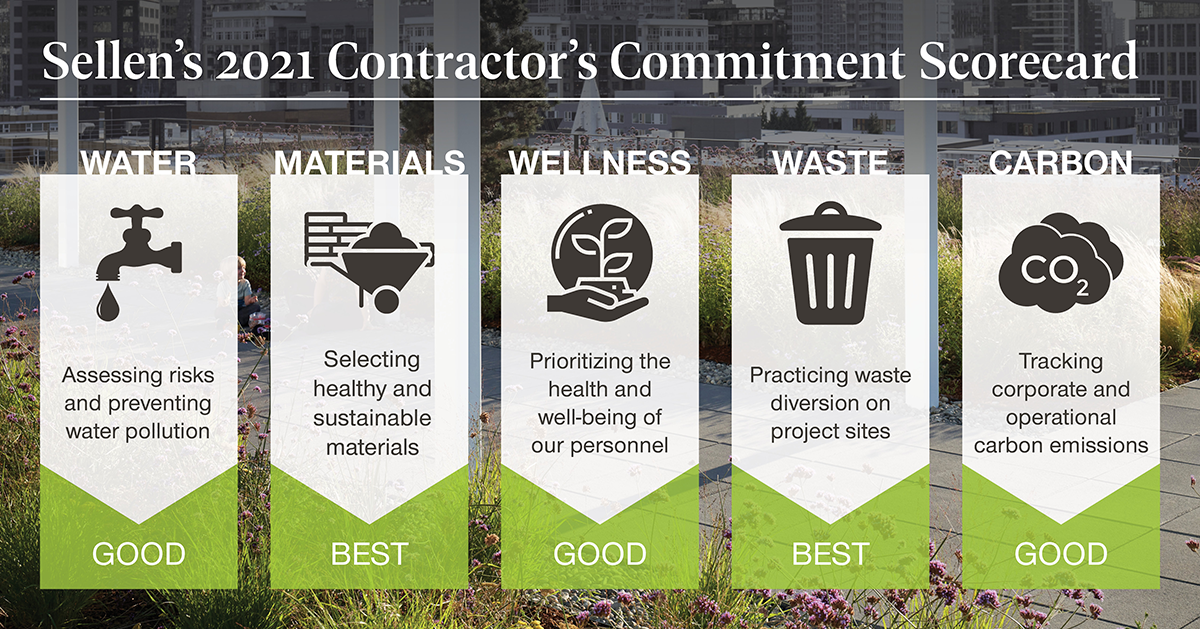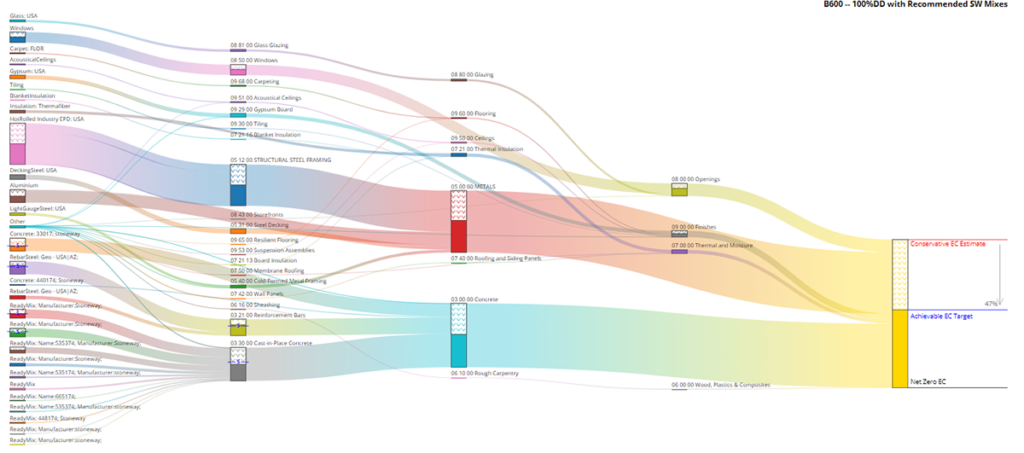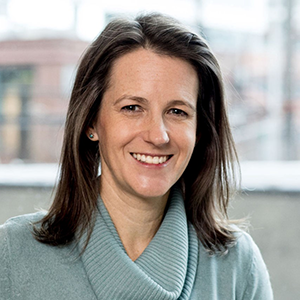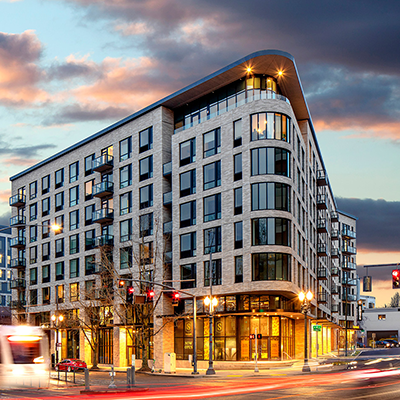Pushing the Boundaries, Leaving a Legacy
by Erin Kirkpatrick and Angi Rivera
Sellen first targeted embodied carbon in 2013 on the Helen Sommers Building, a design-build project with ZGF Architects for the State of Washington. The 234,000-square-foot, five-story office building included significant sustainability achievements, including a 71% reduction in greenhouse gases (GHG) from building operations. In addition, the design-build team focused on minimizing the embodied carbon in concrete by requiring Environmental Product Declarations (EPDs) for almost all mixes. Sellen proposed creating new EPDs for the project’s concrete mixes to measure the team’s efforts to reduce embodied GHG impacts when compared to baseline, business-as-usual concrete mixes.

Helen Sommers Building – Photo by Benjamin Benschneider
This project was the first publicly funded project in Washington to require EPD data for concrete mixes, and 99.7% of the Helen Sommers Building’s concrete has EPD data. By redesigning the concrete mixes, the project reduced the overall embodied carbon in its concrete by 27% compared to similar mixes in the Pacific Northwest and 31% compared to national averages. As a result of this project, supplier Cal Portland produced EPDs for 90 of its commonly used mixes in its three Puget Sound plants. Prior to this project, only five concrete EPDs were available in Washington. Today, the number of EPDs for concrete mixes produced in Washington is in the thousands.
A decade after our early work to reduce embodied carbon at the Helen Sommers Building, many of Sellen’s projects are pursuing ILFI’s Zero Carbon certification and LEED Whole Building LCA material impact reductions. Using tools like EC3 and OneClickLCA to estimate and track our performance throughout design and construction, we are typically able to realize significant embodied carbon reductions compared to industry averages.
A member of Sustainable Construction Leaders (SCL), a national peer group facilitated by Building Green, Sellen joined the Contractor’s Commitment in 2019. The Contractor’s Commitment demands transparency, accountability, and continuous improvement from its participants to achieve positive change in our industry. We became one of the first signatories to commit to tracking and reporting against five impact categories: Carbon, Water, Waste, Materials, and Wellness. Each of the five categories is evaluated on a Good/Better/Best scale. We were one of only nine companies in the country to report in 2021 – the program’s pilot year — and we achieved Good in three categories and Best in two.

This year, Sellen partnered with two other local contractors to establish the Puget Sound SCL chapter. The goal of this partnership is to collaborate, share knowledge, and collectively further sustainable construction efforts in our region.
Decarbonization in Practice
The built environment generates nearly 50% of annual global CO2 emissions. Building materials and construction are responsible for 20% of those total emissions. As builders, we are responsible for analyzing our operations and doing our part to implement reduction strategies wherever feasible.

Sellen calculates embodied carbon in construction with the help of the EC3 tool
Calculating embodied carbon in construction is an emerging science, and there’s still a great deal of uncertainty around how procurement and construction can impact sustainability or carbon goals. Clients want to build sustainable spaces, but there’s a lack of awareness and reliable data. To that end, Sellen often requires subcontractors to provide EPDs during procurement. This requirement addresses the issue in two ways: it requires suppliers to look internally and quantify their impact, encouraging reductions in carbon intensity, and it enables a more holistic decision-making process for Sellen and our clients by rolling embodied carbon metrics into project tracking. Just like project schedule and budget updates, we provide owners with regular, timely updates with the latest embodied carbon data.
Sellen conducted a carbon footprint evaluation of our company for the Contractor’s Commitment in 2021. This study showed that our most significant opportunity for carbon reduction is in site operations. With only one corporate office and a warehouse facility, our non-project footprint is relatively small. We are now looking closely at our data and identifying opportunities to make targeted reductions over the coming years. Realizing tangible reductions will require partnerships and advocacy through our supply chain to promote the development of new solutions, including electrification and more efficient alternatives to current industry-standard solutions. We are committed to pushing for change and implementing cutting-edge technologies and equipment.
Moving into the future
While Sellen has been pushing for additional data and market transformation for some time, the AEC industry is at the very beginning of this work. Many working in this space understand that our window to minimize the impacts of climate change is closing rapidly, and we believe that focusing on reducing carbon in materials and construction can make a substantial impact. It starts with simply asking for the data, benchmarking against industry norms, and using that data to inform decision-making along the way.
About Sellen
As a leading general contractor in the Pacific Northwest for more than 77 years, Sellen is committed to building our community sustainably, minimizing the impact on future generations and contributing to a lasting, positive legacy in the built environment. We strive to push industry boundaries, and we have advocated for sustainable practices and worked to reduce carbon in materials and operations for over a decade.

Angi Rivera
Director of Sustainability

Erin Kirkpatrick
Sustainability Manager
Sellen conducted a carbon footprint evaluation of our company for the Contractor’s Commitment in 2021. This study showed that our most significant opportunity for carbon reduction is in site operations…Realizing tangible reductions will require partnerships and advocacy through our supply chain to promote the development of new solutions, including electrification and more efficient alternatives to current industry-standard solutions.






